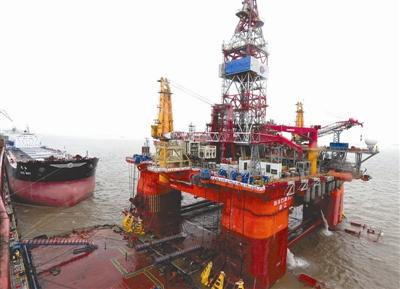
The oil rig, named CNOOC981, is launched Monday in Shanghai.
China has inaugurated its most advanced deep-sea oil platform capable of operating at up to 3,000 meters under the surface of the ocean.
This move boosts the country's offshore tapping capabilities and enhances its leverage in securing marine resources often contested by other regional players.
The announcement, seen as a major technology breakthrough, will serve a national energy ambition as authorities now look to the high seas for answers to soaring energy demands.
The oil rig, named CNOOC981, was launched Monday in Shanghai, where it was delivered to China National Offshore Oil Corp (CNOOC), the State-owned oil company with exclusive rights to exploit offshore oil and gas fields.
CNOOC spent 6 billion yuan ($922.37 million) in developing the rig, which was specially designed to drill deep sea oil fields. It was built over the course of three years by China State Shipbuilding Corp (CSSC).
The rig weighs 31,000 tons with a deck the size of a standard football field. It is able to undertake offshore operations at up to 3,000 meters under the ocean and extract for oil at a depth of 12,000 meters, according to CSSC. This is a massive increase to China whose previous oil extraction capacity was limited to 500-meter-deep seas.
The oil rig will start its voyage from Shanghai on Thursday for a trial cruise before starting drilling in the South China Sea in July, according to a report by the People's Daily.
This will help China establish a more important presence in the largely untapped southern part of the South China Sea.
Energy-thirsty countries around the South China Sea have been tapping its oil resources for years, but this will mark the first instance of China's influence spreading to its southern tides.
China's Ministry of Foreign Affairs has repeatedly condemned oil drilling in the area by some Southeast Asian nations as Beijing holds it has indisputable sovereignty over the Nansha Islands and its adjacent waters.
Surrounding countries have increased oil drilling from the sea in recent years, resulting in a loss equivalent to 20 million tons of oil annually for China, Song Enlai, chairman of CNOOC's board of supervisors, told Oriental Outlook magazine. The total output of China's offshore oil and natural gas stood at 50 million tons of oil last year, CNOOC reported.
The CNOOC981 oil rig is "undoubtedly a milestone in China's oil drilling industry," Lin Boqiang, director of the Center for Energy Economics Research at Xiamen University, told the Global Times. "It is always a first-come-first-served game when vying for non-renewable resources in disputed sea areas, as the resources are not infinite."
The capability to drill so far down is a differentiating factor that countries like Vietnam and the Philippines have not yet acquired, Lin added.
By mid-2010, 180 oil and natural gas fields and more than 200 oil-gas-bearing strata had been detected in the South China Sea, with most located at between 500 and 2,000 meters. Though large oil fields have been found in the area, exploitation by Chinese oil drillers seems to have been slow.
In 2009, China inaugurated a project to drill its biggest and deepest offshore natural gas field, the Liwan 3-1 field, at a cost of 35 billion yuan and which will begin production in 2013.
Zhao Ying, a scholar with the Chinese Academy of Social Sciences, told the Global Times that the new drilling platform is strategically important.
"The value of the South China Sea natural resources is immense. Now that technologies are available for China to tap resources there, efforts to guard its operations and deter foreign illegal explorations become meaningful and necessary," Zhao said.
China has stepped up efforts to explore and materialize offshore resources. The CNOOC981 oil rig is only part of a 15-billion-yuan project to ramp up the deep sea exploration fleet, the Oriental Outlook reported. Following the giant rig, more oil exploitation facilities will be put to use.
The country is seeking more dependence of the marine industries as a strategic development move. The 12th Five-Year Plan (2011-2015) advocates more scientific and systematic utilization of marine resources and coastal areas as energy demand soars and inland resources drop.





